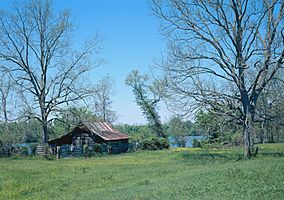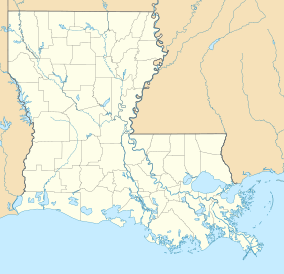Cane River Creole National Historical Park facts for kids
Quick facts for kids Cane River CreoleNational Historical Park |
|
|---|---|

Tenant farmer log house in the Cane River Creole National Historical Park
|
|
| Location | Natchitoches Parish, Louisiana, United States |
| Nearest city | Natchitoches |
| Area | 207 acres (84 ha) |
| Established | November 2, 1994 |
| Visitors | 26,996 (in 2011) |
| Governing body | National Park Service |
| Website | Cane River Creole National Historical Park |
The Cane River Creole National Historical Park was created in 1994. Its main goal is to protect the history and culture of the Cane River area in Natchitoches Parish, Louisiana. The park is about 63 acres big. It includes two old French Creole cotton plantations: Oakland and Magnolia.
These plantations still look much like they did long ago. They have their original buildings, landscapes, furniture, and old tools. They are the best-preserved French Creole cotton plantations in the United States. The park has 65 historic buildings and over a million old items. They help the National Park Service share the story of farming over 200 years. This story includes the landowners, enslaved workers, and tenant farmers who lived here. The park is also part of the Louisiana African American Heritage Trail.
A key part of the park is showing and explaining Creole culture. In old Louisiana, "Creole" meant things born or made in the New World from Old World beginnings. This could be people, buildings, or even animals. For people, Creole meant anyone born in Louisiana during the French and Spanish times. This was true no matter their background. Today, Creole still includes people from many different backgrounds. It connects them to their early Louisiana roots. This includes people whose families came from Europe, Africa, or a mix of cultures. The Prud'hommes of Oakland and the LeComtes of Magnolia were French Creole families. Their homes and plantations showed the French Creole style of building and living.
The old landscapes and many buildings at Oakland and Magnolia plantations tell important stories. They show how workers, both enslaved and free, lived. Later, after the Civil War, tenant farmers worked the same land. They adapted to many changes over two centuries. Today, their descendants still keep many of these traditions alive.
Contents
Magnolia Plantation: A Look Back in Time
The story of Magnolia Plantation began in the mid-1700s. The French LeComte family first received land grants here. Later, the French Hertzog family continued its history. In 1753, Jean Baptiste LeComte got land in Natchitoches Parish. He started the Shallow Lake plantation. He mostly grew tobacco and food for his family. The LeComte family did well under French and Spanish rule. They became one of the most successful landowning families in Natchitoches Parish. By the early 1800s, they were growing cotton and buying more land.
Growing Prosperity and Change
In the 1830s, Ambrose LeComte II took over the land that became Magnolia Plantation. During this time, the LeComtes were very rich. They built most of the buildings you can still see at Magnolia today. By the 1850s, Ambrose and his wife Julia retired. They moved to their townhouse in Natchitoches. Ambrose then focused on his horse racing business. In 1852, Ambrose's son-in-law, Matthew Hertzog, began managing the plantation. The Hertzog name became strongly connected to Magnolia.
Civil War and Rebuilding
The good times for the plantation family ended with the Civil War. During the war, Union soldiers burned Magnolia's main house. This happened during the Red River Campaign. Both Confederate and Union armies destroyed crops and other plantation buildings.
After the Civil War, the LeComte-Hertzog family rebuilt their plantation. They also rebuilt the main house. They changed how the land was worked. They used a new system called sharecropping. This was done by freedmen, who were formerly enslaved people. They also rented some land to tenant farmers, many of whom were Creoles of color.
Sharecropping was an agreement between the landowner and the farmer. The sharecropper farmed a part of the owner's land. In return, they got a share of the crops or the money from selling them. The plantation owner often provided seeds and tools. On big plantations like Magnolia and Oakland, there was a store. This store sold goods to the sharecroppers. Many sharecroppers often faced challenges. They would owe money to the plantation store. This made it hard to save money.
Modern Times at Magnolia
In the 1900s, the old plantation way of life slowly changed. Machines began to do much of the work in the cotton fields by the 1960s. This meant fewer workers were needed. But many old community traditions continued. At Magnolia, workers and owners still enjoyed baseball and horse races. They also celebrated Juneteenth. The last black family left the plantation in 1968. The Hertzog family then hired a farming company to work the land.
Today, Magnolia Plantation is a Bicentennial Farm. It is also a National Historic Landmark. The main house and the farming land at Magnolia are still owned by the Hertzog family. They are not open to the public.
Visiting Magnolia's Historic Buildings
However, many other buildings at Magnolia are part of the Cane River Creole National Historical Park. These include the Plantation Store, the Overseer's House, the Blacksmith Shop, the Slave/Tenant Quarters, the Gin Barn, Cotton Picker Shed, and Carriage House. These are open to visitors. The gin barn has two types of cotton gins. It also has a rare 1830s mule-powered cotton press. This is the only one of its kind still in its original spot. The park shares the stories of the many different people connected to Magnolia. It shows their strength, cleverness, and how they worked together.
Oakland Plantation: A Family's Legacy
Oakland Plantation began in the 1700s. The French Creole Prud'homme family received land grants for it. In 1789, Emanuel Prud'homme got land from the Spanish government. Spain ruled Louisiana at that time. Emmanuel was one of the first planters to grow cotton in the area. He began to buy enslaved workers to farm the fields and build the plantation structures. In 1818, Prud'homme started building his plantation home. In the late 1820s, Emanuel's son, Pierre Phanor Prud'homme, took over managing the plantation.
A Self-Sufficient Community
Like Magnolia and most large plantations in the early 1800s, the Prud'homme plantation was a self-sufficient community. This means they grew or made almost everything they needed. Cotton was their main crop. But they also grew food for people and animals. They built barns for mules, chickens, horses, and turkeys. They also built homes for the overseer and enslaved people. There were also work areas like a wash house and a carpenter shop. An unusual building was the pigeonnière. This was where pigeons were raised for food.
Civil War's Impact on Oakland
Pierre Phanor managed the plantation since the 1820s. But he didn't own it until 1845, after his father died. Phanor continued to run the plantation well until the Civil War. During these years, enslaved people did many different jobs. They farmed the land, processed cotton, built structures, cared for animals, and made most of the goods needed on the plantation.
The Civil War brought destruction to the Cane River area. During the Red River Campaign, both the Union and Confederate armies destroyed plantation buildings, crops, and animals. At the Prud'homme plantation, the cotton gin was burned. Stories about how the main house survived and what happened to Phanor are not fully clear. One family story says Union soldiers arrested Phanor. He became sick while being moved and died in Natchitoches.
Rebuilding and New Beginnings
After the war, Phanor's two sons divided the plantation. Jacques Alphonse Prud'homme kept the land with the main house. This was on the west side of the Cane River. Pierre Emmanuel Prud'homme took the land on the east side. He started his own plantation called Atahoe.
Alphonse renamed his home Oakland. He began to rebuild his wealth. He adapted to the new system of free labor. He hired freedmen as sharecroppers. Some Creoles of color rented land separately as tenant farmers. During this time, the Prud'hommes opened a store and post office at Oakland. This provided supplies and services for sharecroppers and tenant farmers. The plantation store stayed open until 1983. It served the community even as the number of farm workers decreased. Low cotton prices and a boll weevil problem in the early 1900s made times tough until after World War II.
Oakland in the Modern Era
Modern changes came slowly to Cane River. Phanor Prud'homme II bought the family's first car in 1910. Most people still used mule-drawn wagons. By the 1960s, the family started using machines for farming. Machines did more of the work once done by mules and people. During and after World War II, many black workers left the plantations. They moved north in the Great Migration to find jobs in war factories.
Today, Oakland Plantation is a National Historic Landmark and a Bicentennial Farm. It is open to the public as part of the Cane River Creole National Historical Park. Oakland's old buildings, sheds, stores, and tenant cabins show what daily life was like on a working cotton plantation. The site gives a glimpse into the Creole colonial culture. This culture was kept alive by French families like the Prud'hommes. It was also shaped by generations of black people and Creoles of color.
Visiting Oakland and Magnolia
The grounds of both plantations are open every day. They are open from 8:00 a.m. until 4:00 p.m. They are closed on New Year's Day, Thanksgiving, and Christmas. Visitors can take a self-guided tour of the grounds during these hours. A guided tour of the Oakland Slave/Tenant Quarters is available daily at 12:30 p.m.
A park ranger leads tours of the Oakland Plantation main house every day at 1:00 p.m. More tours might be available if there are enough staff.
Tours of the Magnolia grounds require a reservation. The main house at Magnolia is on private property and is not open to the public.
Address
Here are the addresses for the plantations:
- Oakland Plantation
- 4386 Highway 494
- Natchez, LA 71456
- Magnolia Plantation
- 5549 Highway 119
- Derry, LA 71416



